GARRY OAK ECOSYSTEMS
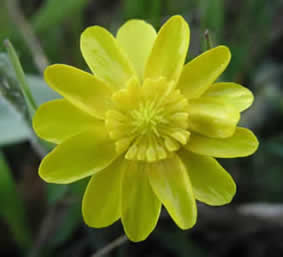
California buttercup (Ranunculus californicus). Photo by Matt Fairbarns
by
Matt Fairbarns
Aruncus Consulting
Introduction and Overview
What are Garry Oak and Associated Ecosystems?
The southeast fringe of Vancouver Island and several of the southern Gulf Islands are home to Garry oak woodlands, maritime meadows, vernal wetlands, coastal bluffs and rock outcrops which have a distinctive flora. These Garry oak and associated ecosystems support the highest plant diversity of any terrestrial ecosystem complex in coastal British Columbia. They tend to occur within a mosaic of other ecosystem types, characterized by forests Douglas-fir, Western red cedar, Western hemlock and/or Shore pine, which are more widespread in British Columbia and are therefore not considered Garry oak or associated ecosystems.
A Unique Climate
The Garry Oak and associated ecosystems are a product of the unique climate of the region. Winters are mild - relatively warm, low pressure areas dominate coastal areas because the Coast Mountains impede the southward movement of cold high pressure systems. Winter temperatures along the coast are further moderated by proximity to the ocean, which is dominated by mild waters of the California Current all year long. The scarcity of snow and rarity of hard frosts allows vegetation to remain green throughout the winter.
The region lies in the rain-shadow of the Vancouver Island and Olympic Mountains, which intercept moisture from the prevailing systems which move in from the Pacific. As the systems continue to move eastward they are forced to rise over the Coastal Mountains, resulting in moister, cloudier conditions in the lower mainland of British Columbia. As a result, southeast Vancouver Island and the southern Gulf Islands have drier winters than occur elsewhere in south coastal British Columbia.
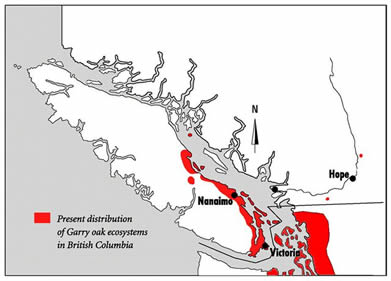
Present Distribution of Garry Oak Ecosystems in British Columbia.
Map courtesy of the Province of British Columbia © 1993
Summers are cool and dry. A large semi-permanent high pressure area extends over the northeastern Pacific, dominating the general circulation in western Canada. The Olympic, Vancouver Island and Coastal Mountains intercept much of the moisture from systems moving into the region. May, June, July and August each bring less than 25 mm of mean monthly precipitation and pronounced moisture deficits develop. Strong moisture deficits turn much of the meadow and woodland vegetation brown in mid-summer. Summer temperatures are greatly mediated by proximity to the ocean and daily maximum temperatures often increase by several degrees as one moves inland on a warm summer day.
The combination of relatively clear winters and dry clear summers, along with a southern location, determine that southeast Vancouver Island has the greatest annual amounts of sunshine in British Columbia.
Garry Oak Woodlands and Forests
Garry oak woodlands have developed as a result of an interplay between climatic, edaphic and/or cultural factors. Within the sub-Mediterranean climatic zone, they tend to occur on sites that have shallow or very well drained soils. In some places they extend onto areas of deeper soil, especially where First Nations once used fire to stimulate the growth of food species – particularly camas bulbs that provided a storable form of starch. They probably also used fire to improve forage for game species (elk and deer).
The richest, least droughty Garry oak sites on deeper soils tend to have a well-developed canopy of tall Garry oaks above a dense shrub understory characterized by Rosa nutkana (Nootka Rose), Symphoricarpos albus (Common Snowberry) and Holodiscus discolor (Ocean Spray). The herb layer is often relatively sparse, as a result of the dense shading and heavy competition provided by the shrubs. Camassia quamash (Common Camas) and C. leichtlinii (Great Camas) are rarely abundant. Many ecologists believe that their current structure developed as a result of fire exclusion and that this ecosystem type developed as a result of frequent First Nations burning that prevented the development of a conifer canopy or a shrubby understorey. Other ecologists believe that these shrubby Garry oak forests are a natural element of the landscape.

Great camas (Camassia leichtlinii). Photo by Neil L. Jennings.
On slightly drier sites, usually with deep soils but gentle slopes, Garry oak forests and woodlands tend to have a more open understory. Symphoricarpos albus tends to be less abundant while Rosa nutkana and Holodiscus discolor are usually sparse or absent. The herb layer is typically well developed and Camassia spp. tend to be quite prominent in the spring. When the stands are in good condition, their herb layer is usually dominated by robust native species such as Melica subulata (Alaska oniongrass), Elymus glaucus (Blue wildrye), Carex inops (Long-stoloned sedge) and Sanicula crassicaulis (Pacific sanicle). Many sites have been heavily altered through invasion by exotic weeds including Cytisus scoparius (Scotch broom), Dactylis glomerata (Orchardgrass), Poa pratensis (Kentucky bluegrass), Bromus sterilis (Barren brome) and Vicia sativa (Common vetch).
A third Garry oak woodland type, characterized by a grass-herb understory, often occurs on gentle slopes with shallower soils over bedrock. The relatively thin soils tend to dry out earlier in the summer so the shrub layer tends to be sparse, although Mahonia aquifolium (Tall Oregon-grape) is often present and occasionally abundant. More typically, drought-resistant herbs such as Lonicera hispidula and Festuca idahoensis dominate the lower vegetation. Other prominent native species include tall grasses such as Elymus glaucus and Bromus carinatus (California brome) and forbs such as Sanicula crassicaulis. A number of exotic herbs have invaded this ecosystem type, most notably Bromus sterilis and Vicia sativa.
On very shallow soils with abundant outcropping rock, Garry oak ecosystems are often reduced to stunted woodlands with low trees rooting in rock crevices with pockets of deep soil. Their stems are twisted and their canopies are sparse. While Garry oaks may confer a distinctive appearance to these rock outcrop ecosystems, they do not play a dominant role driving ecosystem processes so the following description applies equally well to rock outcrop and coastal bluff ecosystems associated with Garry oak. The sites dry out quickly in the spring, so mosses tend to dominate - Dicranum scoparium (Broom moss) is most abundant on cooler south-facing slopes while Racomitrium canescens (Rock moss) and Polytrichum juniperinum (Juniper haircap moss) dominate warmer south-facing slopes. The droughty conditions greatly limit shrub growth. The herb layer also tends to be sparse, although it usually contains a diverse mix of species that root in shallow soils as well as those that root in deeper soil pockets in rock crevices. Shallow-rooting native species include Selaginella wallacei (Wallace’s selaginella), Sedum spathulifolium (Spoon-leaved stonecrop), Claytonia perfoliata (Miner’s lettuce), Montia parviflora (Small-leaved montia), Cerastium arvense (Field chickweed) and Lotus micranthus (Small-flowered bird’s-foot trefoil). These are augmented by numerous invasive species including Rumex acetosella (Sheep sorrel), Vulpia bromoides (Barren fescue), Aira praecox (Early hairgrass) and Aira caryophyllea (Silver hairgrass). Plants of deeper soil pockets include Elymus glaucus, Camassia leichtlinii, Bromus carinatus and the introduced Bromus sterilis.
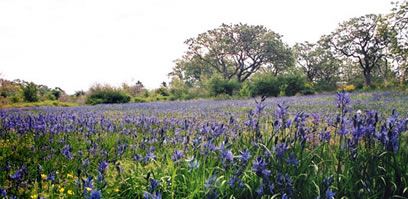
Garry oak meadow, open savanna. Photo by Chris Junck.
Studies of pollen profiles indicate that Garry oak woodlands and forests were probably more widespread during dry periods in the past and, while natural climate change allowed conifer forests to replace Garry oak woodlands, large tracts were still present when European settlement began in the mid 19th century. Level sites with deeper soil were soon converted to agricultural land (cropping and grazing). Urbanization led to further habitat loss and fragmentation. The introduction (deliberate and accidental) of many highly invasive Eurasian plants reduced the quality of much of the remaining Garry oak forest and woodland habitat, while fire suppression led to conifer and shrub encroachment (particularly on sites with deep soil). If future climate change brings drier and warmer conditions, Garry oak woodlands and forests may expand into some areas that are now dominated by Douglas-fir. Unfortunately, the vegetation beneath the Garry oak canopy will likely be dominated by invasive exotics that are well-poised to rapidly occupy suitable sites.
Maritime Meadows
Maritime meadows occur near or along the coast, often interspersed with Garry oak woodlands and forests.
a) Dry maritime meadows
Dry maritime meadows are simply too droughty for trees and shrubs to grow, either because of shallow or excessively-drained soils or exposure to wind. They are often transitional to rock outcrop and coastal bluff communities and tend to be dominated by drought-avoiding ephemeral plants – particularly annual species which can complete their life cycle before the summer drought deepens and perennial bulb plants which break dormancy with the autumn rains and die back as the soils desiccate. The bulb-producing species may take many years before they develop sufficient carbohydrate reserves to support flowering. Many of the other perennials found in dry maritime meadows follow a similar strategy, breaking shoot dormancy in the autumn, slowly building up roots and shoots during the winter and spring, and flowering in late spring. Typical native species of dry maritime meadows include Allium acuminatum (Hooker’s onion), Camassia quamash (Common camas), Triteleia hyacinthina (Fool’s onion), Lomatium utriculatum (Spring gold), Eriophyllum lanatum (Woolly sunflower), Lotus micranthus (Small-flowered bird’s-foot trefoil) and Fragaria virginiana (Common strawberry). Dry maritime meadows may be invaded by Cytisus scoparius but the soils are often too shallow and/or droughty. A number of invasive herbs often occur in dry maritime meadows and are sometimes quite abundant, including Anthoxanthum odoratum (Sweet vernal grass), Bromus hordeaceus (soft brome), Bromus rigidus (Rip-gut brome), Aira praecox (Early hairgrass), Vulpia bromoides (Barren fescue), Cynosurus echinatus (Hedgehog dog-tail grass) and Plantago lanceolata (Ribwort).
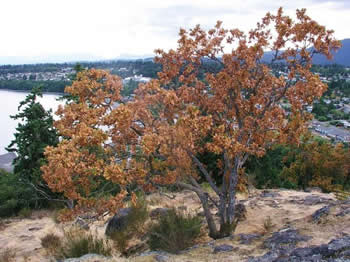
Garry oak, Nanaimo, BC. Photo by Gary Ansell.
b) Moist maritime meadows
Moist maritime meadows tend to have deeper soils and many were created and maintained by First Nations burning. Native shrubs are rarely abundant but both Cytisus scoparius and Ulex europaeus (Gorse) may become quite troublesome on these sites. Robust forbs such as Lomatium nudicaule (Indian consumption plant), Sanicula crassicaulis, Fritillaria affinis (Chocolate lily), Zigadenus venenosus (Death camas), Camassia leichtlinii and Camassia quamash may be quite common. Native bunchgrasses such as Danthonia californica (California oatgrass), Bromus carinatus and Elymus glaucus may also be common. Grazing has often resulted in native grasses being replaced by invasive grasses such as Dactylis glomerata, Holcus lanatus (Common velvet-grass), Anthoxanthum odoratum and Bromus sterilis, along with exotic forbs such as Plantago lanceolata and Vicia sativa.
c) Wet maritime meadows
Wet maritime meadows, which grade into vernal wetlands, may resemble moist maritime meadows but contain some less drought-tolerant species such as Deschampsia cespitosa (Tufted hair-grass).
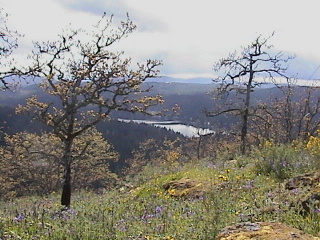
Garry oaks on Observatory Hill, Vancouver Island.
Photo by Brian Klinkenberg
Vernal Wetlands
A suite of vernal wetlands (winter wet, summer dry) occur in shallow depressions in association with Garry oak woodlands. They are found in moist swales within maritime meadows and Garry oak woodlands, as well as in more sharply defined rock-bound depressions in coastal bluffs and rock outcrops. Unlike most other wetlands in British Columbia, vernal wetlands have a cool wet growing season during the winter and spring and a dry dormant season in the summer. Their distinctive flora is adapted to extremes of moisture. Winter flooding and a prolonged summer drought, along with shallow soils, prevent the establishment of woody species and restrict the growth of herbaceous perennials in vernal wetlands. Many species are semi-aquatic winter annuals which germinate during the autumn wetting phase, when soils have become saturated. They, along with a few flood-tolerant perennials, grow through the winter aquatic phase, when the vernal pools contain standing water for extended periods. The winter annuals flower and fruit from early to late spring. Other small annuals, fast-growing but less tolerant of flooding, germinate during the spring drying phase as the soil moisture level declines and soil temperatures rise. The dry summer phase completes the annual cycle. Annual species are only present as dormant seeds in the soil, while perennials enter shoot dormancy to survive the prolonged drought.The most extreme form of vernal wetlands are rocky seeps found in association with rock outcrops and coastal bluffs. Such seeps occur where there is a constant trickle of water throughout the winter and early spring. These seeps dry out as the winter rains taper off and the soils above are no longer saturated. They are the first of the vernal wetlands to dry out and have the longest period of drought.
A Unique Flora
The flora of Garry Oak and associated ecosystems includes a number of plants which are rare or absent from the rest of Canada. Over 70 rare plants have been reported from these ecosystems. Over half of these species have been evaluated by COSEWIC or have status reports nearing completion and these species tend to be ranked Endangered in Canada. This represents one of the greatest concentrations of species at risk in all of Canada.
A number of other species that are more widespread in Garry Oak and associated ecosystems are rare elsewhere in British Columbia and Canada.
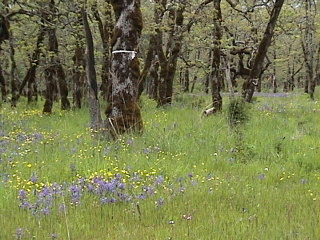
Cowichan Garry Oak Preserve, Vancouver Island.
Photo by Brian Klinkenberg
Conservation of Garry Oak and Associated Ecosystems
Situated in one of the fastest growing areas of North America, Garry oak and associated ecosystems face a number of threats. Large areas were converted to farmland early during European settlement because they were fertile, and easy to clear and cultivate. First Nations burning was eliminated and natural fires were suppressed. A number of invasive species were introduced - accidentally, as forage crops or as ornamentals. As the population of southeast Vancouver island and the southern Gulf Islands swelled, an more natural ecosystems were lost to residential and commercial development. Maritime meadows and vernal seeps, which tend to occur close to the shore, were disproportionately affected. Those areas of Garry oak woodland which persisted, now exist as widely-separated fragments within a highly-modified landscape. This means that natural avenues of dispersal have been disrupted.
There is a long history of community action to protect Garry oak and associated ecosystems. More recently, a number of public groups and government agencies have banded together to create the Garry Oak Ecosystems Recovery Team (GOERT). This team, along with other non-governmental agencies and neighbourhood groups, are engaged in a number of conservation projects. There are several invasive shrub removal projects which take advantage of a large body of enthusiastic volunteers who remove species like Scotch broom, Gorse, Ivy and Daphne from Garry oak woodlands, maritime meadows, rock outcrops and coastal bluffs. Every year, more sites are purchased or protected under conservation agreements. Private landowners, non-governmental agencies and government land managers such as the Department of National Defence and the Canada Coast Guard have changed management practices to improve conservation of natural ecosystems. If you would like to become involved in the conservation of Garry oak and associated ecosystems, learn more about the Garry Oak Ecosystems Recovery Team through their website at http://www.goert.ca.
KEY LINKS
Garry Oak Ecosystems Recovery Team (GOERT)
GOERT Publications
Garry Oak Ecosystems Species at Risk
Garry Oak Ecosystems Invasive Species
GOERT Propagation Guidelines
Fungi of Observatory Hill (A Garry Oak Ecosystem site)
Recommended citation: Author, date, page title. In: Klinkenberg, Brian. (Editor) 2021. E-Flora BC: Electronic Atlas of the Flora of British Columbia [eflora.bc.ca]. Lab for Advanced Spatial Analysis, Department of Geography, University of British Columbia, Vancouver. [Date Accessed]
E-Flora BC: An initiative of the Spatial Data Lab, Department of Geography UBC, and the UBC Herbarium.
© Copyright 2021 E-Flora BC.